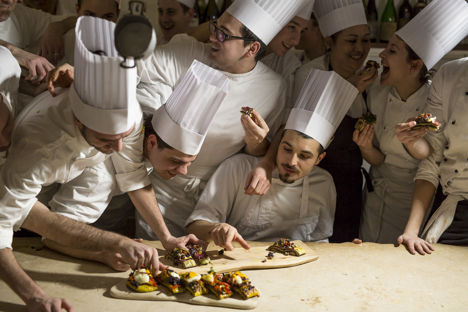
Massimiliano Alajmo: patents and pizza
They say the old recipes are the best – Massimiliano Alajmo disagrees. We talk to the prodigious chef of the three-starred Le Calandre in Veneto about his latest invention – the ‘pjzza’ – and his journey to get it patented.
Massimiliano Alajmo: patents and pizza
They say the old recipes are the best – Massimiliano Alajmo disagrees. We talk to the prodigious chef of the three-starred Le Calandre in Veneto about his latest invention – the ‘pjzza’ – and his journey to get it patented.
Is there anything quite like a perfect pizza margherita? Creamy, stringy mozzarella and rich tomato sauce, smothered over a dough that’s crispy, chewy and charred all at once. Many would argue it’s the perfect example of Italian food done right – a combination of simple cooking and incredible ingredients. The pizza we know and love originates around the early nineteenth century in Naples, but the basic premise goes way back to antiquity. The Greek historian Herodotus, for example, claims that the Persian soldiers of Darius the Great used their shields to cook flat breads around the sixth century BC, which they covered with cheese, dates and herbs. Herodotus also claimed that Persia was home to giant, dog-sized furry ants, so he should always be taken with a pinch of salt, but given that there are historical accounts from ancient Egypt, Greece and Rome that describe flat breads with toppings, it seems one of his more believable moments.
The idea of baking bread in general is one of our very oldest and simplest traditions, born out of the necessity of survival above all else. In today’s world of course, we eat bread for pleasure, so the question becomes – is baking still the best way to cook dough? What happens when food advances, and we discover new techniques that can improve on the traditional methods? That’s exactly what Massimiliano (Max) Alajmo – owner and head chef at the three Michelin-starred La Calandre in Padova – has been asking with his reinvention of the pizza.
Reinventing pizza is no mean feat in a country that is fiercely protective of its food heritage, but Max is a special talent. When La Calandre received a third Michelin star in 2002, he was just twenty-eight years old, making him the youngest chef to ever receive three stars. Since then, he has done a huge amount of research into the effect of food on all the senses. In 2011, he turned his attention to pizza, and started work on a remarkable new concept – a steamed pizza dough – with the aim of protecting Italian food culture by reinventing it.
‘The beauty of it is that the dough requires very little yeast to rise thanks to the steam,’ Max explains. ‘We even ran some successful tests without using any yeast at all. The process of rising and cooking the pizza dough is a much more careful and respectful way of working with the ingredients, and that emphasises the individual characteristics of each element of the dough in the final product.’
Steaming dough is a common technique around the world – particularly in the Far East where steamed buns are stuffed with delicious fillings – but in the world of pizza, it’s a serious departure. The steaming gives the dough an incredibly light, airy crumb which not only makes it more delicious, but also more digestible. ‘It’s the perfect base for highlighting the toppings,’ says Max. ‘The dough is like a sort of pillow full of air that, when bitten into, releases the retro-nasal aromas in the ingredients, intensifying the flavours.’ After steaming, the pizza base is baked, giving the final ‘pjzza’ (his name for it) that perfect combination of airy, chewy dough and crispy crust.
Max is not just a pioneer in the kitchen, but also outside of it. The idea of patenting recipes is a new one in the world of cheffing, but Max pushed for some years to protect his invention, finally receiving a patent for the ‘pjzza’ in 2015. ‘It’s a pretty complex, onerous procedure,’ he says. ‘You can’t patent a recipe, you can only patent a process. They analyze the process to understand if it is truly innovative, then they have to make sure that no one has patented anything similar before. Honestly, I haven’t heard of any other chefs have ever received a patent for a culinary process before, but I am sure they have.’
In the last few years, Max has been busy expanding his new pizza process to create other dishes. He has developed a new gluten-free pizza dough that uses black rice flour, a calzone made with ‘pjzza’ dough (which they're currently trying to patent too, under the name 'maxcalzone') and ‘centopezze’ – a long, hundred-layered ‘pjzza’ – at his restaurants across Italy. In a thousand years, people may look back at 2015 as the year when pizza changed for ever. The only question now is, what sacred dish will Max reinvent next?
